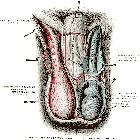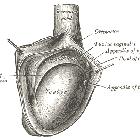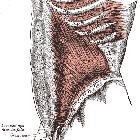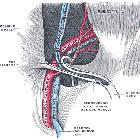Musculus cremaster



The cremaster muscle is the thin fascial muscle of the spermatic cord made of skeletal muscle. It is also referred to as cremaster fascia or simply the cremaster. Its action is to retract the testes, important in thermoregulation and spermatogenesis.
Gross anatomy
It is derived from the internal oblique muscle and aponeurosis and, as some authors report, the transversus abdominis and transversalis fascia. As the testes descends through the deep inguinal ring, inguinal canal and then the superficial inguinal ring during development, the muscle layers traversed contribute to the fascial sheet which retains muscular fibers. The transversus muscles fibers spiral along the cord and some return up to attach to the pubic tubercle. A larger component originates from the internal oblique fibers, some of which also return to the pubic tubercle.
Arterial supply
Its arterial supply is from the cremasteric artery, a branch of the inferior epigastric artery.
Venous drainage
Like the testis, venous blood drains into the pampiniform plexus of veins.
Innervation
The cremaster is innervated by sympathetic and somatic fibers of the genital branch of the genitofemoral nerve.
Action
Cremaster reflex
The cremaster reflex is elicited by gently stroking the skin of the medial upper thigh which causes ipsilateral contraction of the cremaster muscle and retraction of the testes. The sensory nerve stimulated is the ilioinguinal nerve and the motor nerve is the genital branch of the genitofemoral nerve. It is more pronounced in neonates and children and may even retract the testes into the spermatic cord. When exaggerated, it can simulate cryptorchidism.
History and etymology
The word "cremaster" derives from the Ancient Greek "to hang" (κρεμαστήρ, kremastḗr, “suspender”).
Siehe auch:

 Assoziationen und Differentialdiagnosen zu Musculus cremaster:
Assoziationen und Differentialdiagnosen zu Musculus cremaster:


